What to plant next to the thuja on the site?
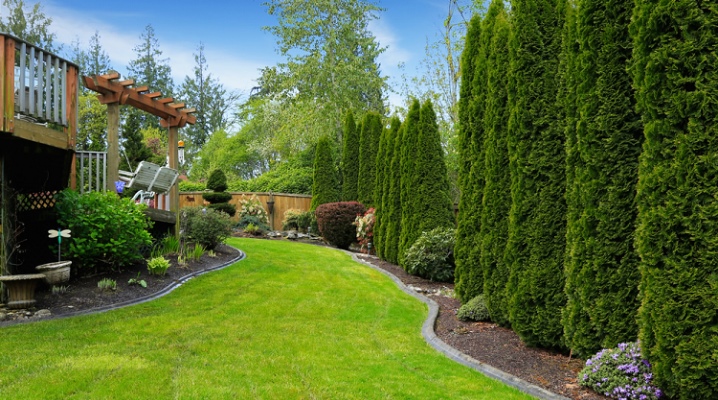
Being engaged in landscape design, many prefer conifers. When planting a thuja on a site, it should be borne in mind that not all plants get along next to it. We will talk about what is best to plant next to the thuja on the site, and which plants are best to avoid.
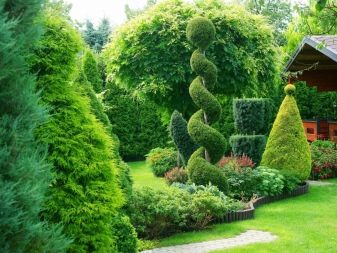
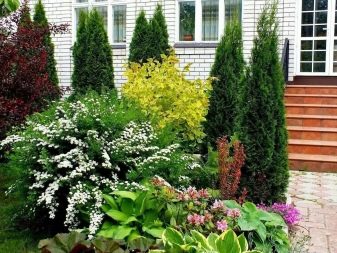
Best options
Thuja is a versatile plant that will look great both as a single object and in the neighborhood with other "companions". Thuja will look perfect against the background of any lawn. It will be a great option for a rocky garden. Conifers are used in the landscape for a reason. Thuja is very good as a live fence. An excellent choice would be to plant tall and dwarf varieties, as well as varieties that differ in the tone of the needles.
If you want to arrange a more original composition together with thuja, you can plant all kinds of flowers, shrubs, and plant trees on the site. But in order for plants to fully develop, their compatibility must be taken into account. They must have the same need for area illumination, watering, soil acidity.
And also an important factor is the aesthetic component. Their neighborhood should be harmonious, the plants should emphasize the attractive appearance of each other.
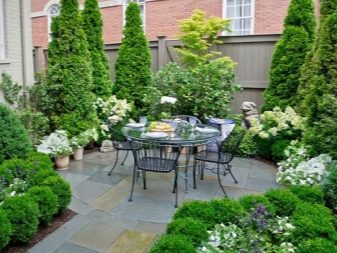
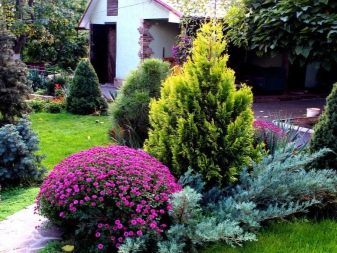
Typically, landscape designers use the west, east or folded.
- Thuja oriental has a pyramidal crown and long, numerous, branchy branches growing vertically. This plant can grow up to 100 years or more, which makes it possible to use it to decorate parks and squares. When creating a hedge, it is advisable to use high, medium-sized and dwarf varieties. These include the columnar thuja Pyramidalis, the small Justinka, or the golden Aurea Nana, an evergreen tree with a pronounced trunk reaching a height of up to 2 meters.
- Western thuja. It was brought from North America. The tree does not grow rapidly. It has a dense crown, the shape of which from pyramidal later becomes ovoid. The most popular varieties include Smaragd (tall variety), Danika, Globoza (globose), Tini Tim, Teddy varieties, which are dwarf trees.
- In the southern regions, folded thuja grows, having a pyramidal crown and thick, drooping branches. Cultivated varieties: Zebrina, Forever Goldie. The place for planting directly depends on the shape of the crown.
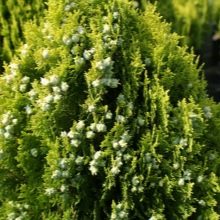


Plants are grown:
- in the vicinity of other trees;
- on flower beds, slides, ridges;
- in the form of a hedge;
- as a focal plant.
Rhododendrons with hydrangeas will go well with high thuja. And also plantings with juniper look spectacular. Smaller plants include primrose, incense, hosts. Bulbous plants will also look organic.
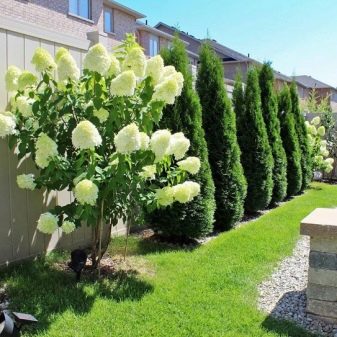
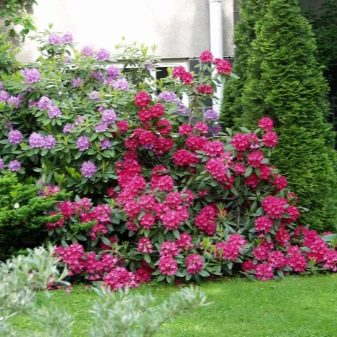
Flowers
Decorating the site with perennials would be a great idea. Bright flowers adjacent to thuja will look very organic. Such joint plantings will allow you to keep the site in the most advantageous form, giving you the opportunity to admire the beauty of the plants for a long period. The choice of perennial plants will allow you to get an original and vibrant composition. Hydrangea, lilac, lavender, clematis and marigolds will look great next to thuja.
- Hydrangea begins to bloom in May, and for a long time continues to delight with the amazing beauty of lush inflorescences.
- Astilba... Having planted this perennial on the site, you can forget about it for several years, since the plant is able to grow safely for a couple of decades in one place.
- It will look good next to a tall tree delphinium... Often the height of the plant reaches one and a half meters. In summer, the delphinium pleases with the abundant flowering of brushes of blue, white or pinkish color.
- Spherical thuja will go well with delphiniums and phloxes. And also hyacinths can act as a neighbor, which from the very early spring will begin to delight with beauty. Thanks to the unusual flowers, characterized by curliness, the site instantly transforms after winter, becomes brighter and juicier.
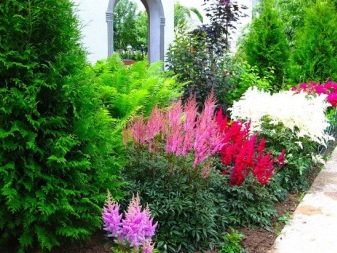
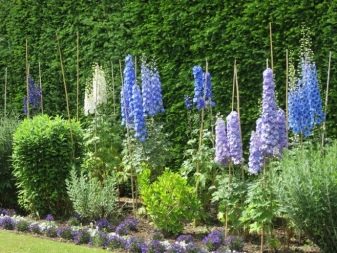
In addition, thuja can be a good neighbor for lilies, pansies, and irises. When using annuals, the flower garden with thuja can be renewed annually along with a change of scenery. They will go well with thuja and roses, but when choosing them, it should be borne in mind that it is better to plant roses at a distance of 1.5 meters from the coniferous tree.
When combining crops, it is necessary to initially break the rose garden, then wait up to 4 years until the bushes grow strong roots, and only after that plant the thuja... By choosing the right varieties that bloom at certain periods, you can watch the non-stop flowering of the flower bed from spring to the very frost.

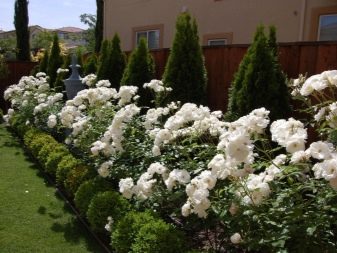
Trees
Landscape compositions should be carefully planned, given that it is difficult to transplant mature trees to another location. With thuja, you can plant different types of deciduous and coniferous trees next to it. On the site will look good:
- trees with a weeping crown resembling a fan or an open umbrella;
- trees with large foliage;
- plants with contrasting colors.
Neighborhood with Japanese maple, elm, crimson or catalpa will transform the site and improve its aesthetic appearance.
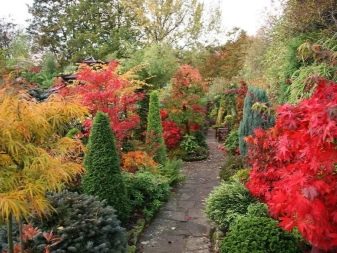
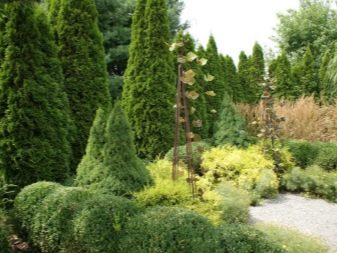
When choosing a deciduous tree as a neighbor for a thuja, you should consider what color the plant will have, when it will bloom, in what time frame, and how the foliage will look in the fall. Thuja will look organic with other conifers, for example, in the vicinity of a spruce, juniper or pine. In large areas, it is advisable to make a whole coniferous composition. Given the good compatibility of conifers, such a flower bed will delight in appearance throughout the year, giving the fragrant smell of the forest. Hoopsi spruce can be used as a suitable neighbor for western thuja. Spruce has a wonderful silvery-bluish tint, grows up to 5 meters in height. As an addition to the coniferous composition, juniper bushes are suitable.
For small areas, it is advisable to use dwarf thuja varieties with their rounded shape. It is conifers that are considered the most suitable for this design. Dwarf varieties Danica or Mr. Bowling Ball will go well with pyramidal trees such as Kornik or Aurea Nana. Low hedges or low curbs are often built from dwarf and medium-sized trees. A row with repeating elements will look nice. It is better to plant plants with a contrasting color or texture next to a spherical plant.
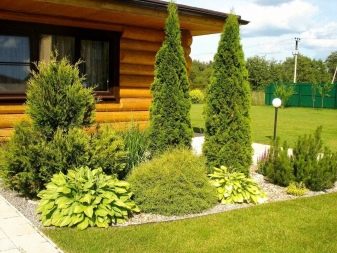

Shrubs
Perennial shrubs will look no less impressive next to thuja. They have similar growing conditions and do not produce vigorous growth. When creating a coniferous mixborder, you can use:
- euonymus;
- jasmine;
- barberry;
- spirea.
In addition, other shrubs are suitable, such as derain, buldenezh, magnolia. If thuja is used as the center of the composition, it is often supplemented with feather grass, spikelet, New Zealand sedge, and fescue. Using cultivated or semi-wild cereals, you can greatly diversify the design of the site.

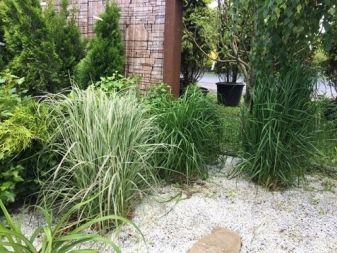
What shouldn't be planted?
In the garden where pears, cherries, apple trees, rowan trees grow, it is undesirable to plant conifers, especially if they are in the immediate vicinity... It is not recommended to plant fruit trees next to thuja, as this can directly affect a decrease in yield. Such neighbors will interfere with each other, low compatibility will lead not only to a decrease in yield, but also to the drying of the branches. Thuja will absorb moisture much faster than fruit plants and shrubs, this will interfere with their full development. Therefore, it is better to plant these trees at a sufficient distance from each other.
This applies not only to trees, but also to shrubs. Currants, raspberries or gooseberries in such a neighborhood will quickly wither away. Not a place next to thuja and annuals. Digging the soil annually can damage the root system of conifers. The main reason for incompatibility can be called the special requirements for the soil, for its acidity.
It is important to take into account the illumination of the site, its humidity, as well as the extent to which these plants are susceptible to diseases and pests. For fruit trees, the best choice will be the neighborhood with flowers, and herbaceous plants can also become their companions.
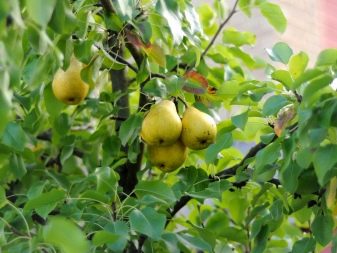
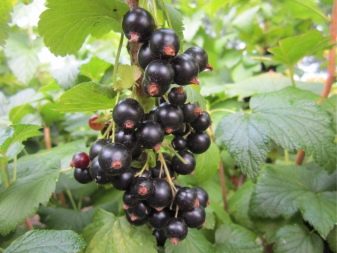
Examples in landscape design
When improving a park area, garden plot or summer cottage, plants should be planted taking into account their compatibility. In this case, the aesthetic component is of no small importance.
- Thuja in landscape design will organically combine with different cultures... So that it does not get lost, it is advisable not to use many shades during planting. A monochrome planting is able to favorably set off the greens.
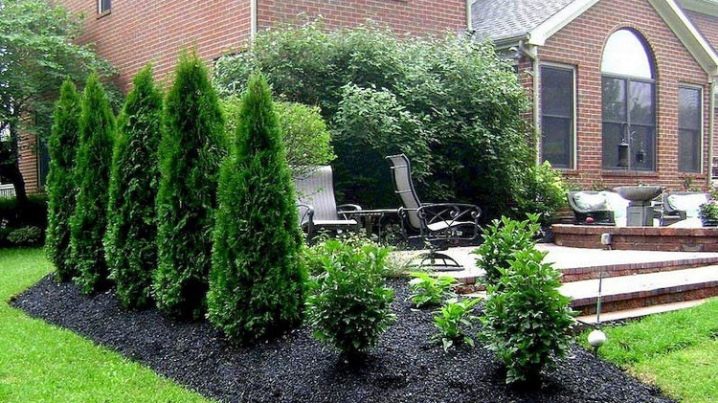
- Using plants that bloom at different times, you can make a beautiful mixborder that will delight you with a riot of colors in the warm season and until the end of autumn.

- Thuja will adorn any site. It will look good on minimalist lawns. It is not necessary to supplement it with other plants, it is enough just to plant it on a mown lawn, or on an area strewn with rubble or pebbles.
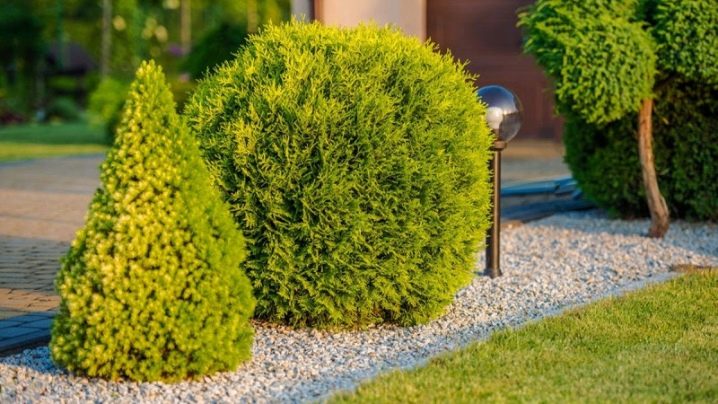
- Coniferous trees will ideally coexist with it, combining into a variety of whimsical compositions.

- Combinations of conifers with vines or other climbing plants will look quite unusual.... At the same time, they can serve as a support for them, without violating the boundaries of the permitted territory. First of all, this applies to climbing roses, herbaceous and semi-shrub clematis.
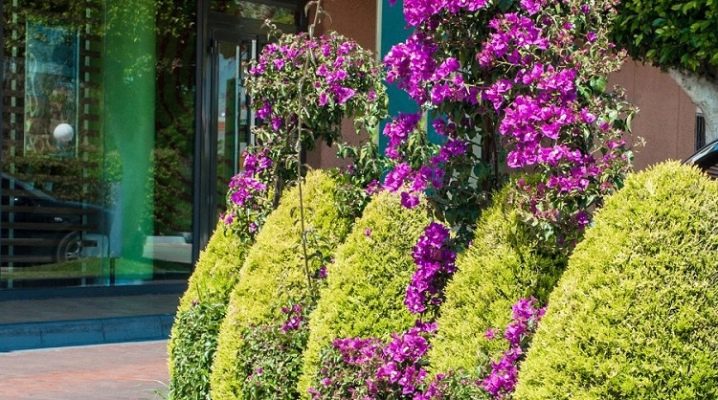
- Bright flowers will perfectly fit into the composition. A single-colored coniferous wall in combination with flowers of different shades and types will look organic and extraordinary.
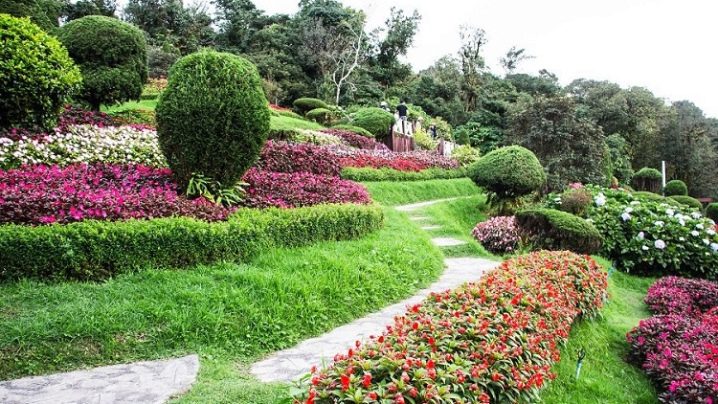
- Selection of perennials in combination with thuja will allow you to create beautiful lawns, taking into account personal preferences.
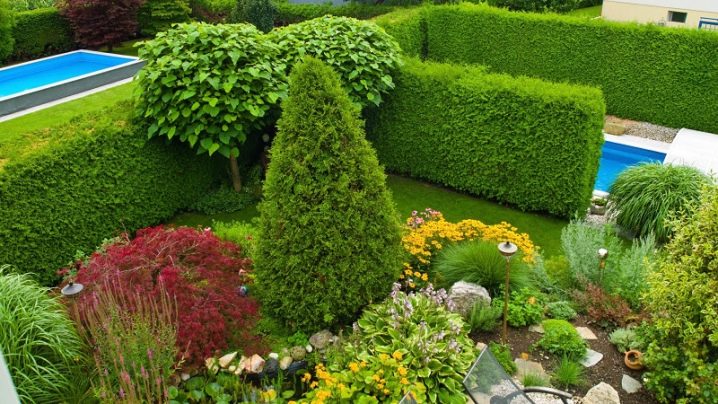
- Harmonious arrangement "Inhabitants" of the flower bed, depending on their size, will allow you to create a beautiful ensemble.
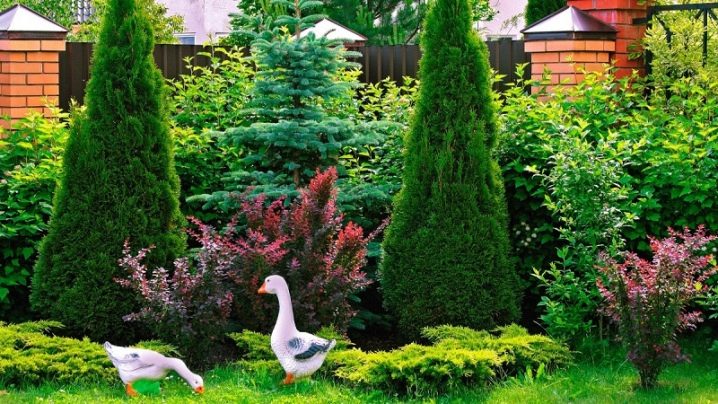
- Due to the variety of flower bed shapes, it is possible to recreate all kinds of compositions that harmoniously complement each other... On a round or oval-shaped flower bed, a pyramidal-shaped thuja in the company of delphiniums, asters, phlox and hyacinths will look perfect.
Their alternate tiered arrangement will allow all plants to be clearly visible, which will also affect the appearance of the flower bed.
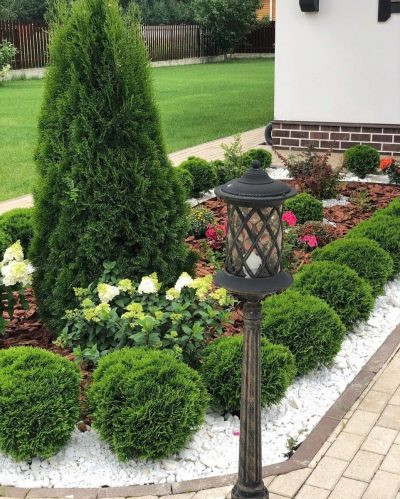



































































The comment was sent successfully.